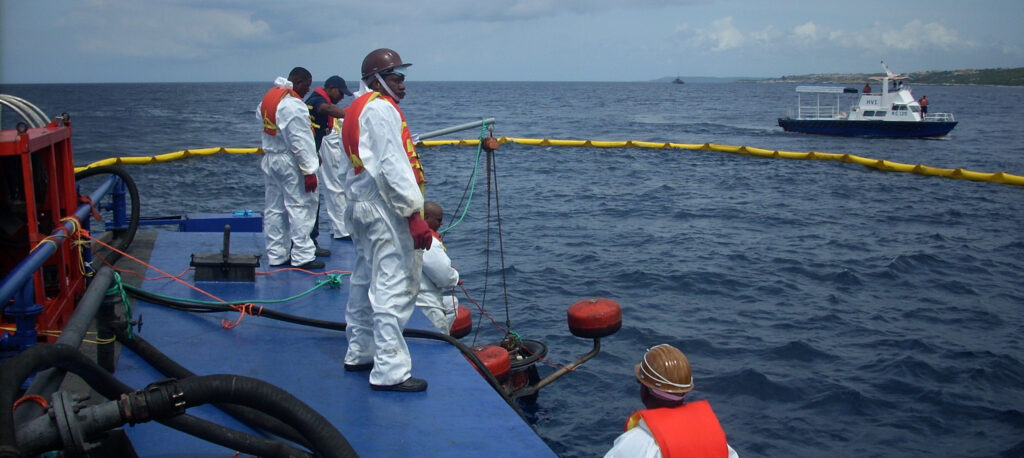Improved disaster risk management for Caribbean ports
2020 December 01: Record-breaking hurricane activity in the Atlantic during 2020 emphasised the timeliness and urgency of the Improved Disaster Risk Management for Ports in the Caribbean project now being implemented by the OAS Inter-American Committee on Ports (CIP).
A record number of 30 tropical storms in the Atlantic during 2020 distributed death, displacement and dislocation across the region and brought the necessity of this CIP project into sharp focus. Indeed, the last regional effort to tackle these issues – the USAID/OAS Caribbean Disaster Mitigation Project – came to an end more than 20 years ago in 1999.
This two-year Improved Disaster Risk Management project, rolled out in September 2019, was designed to bolster the disaster risk management capabilities of ports and maritime authorities in the Caribbean. The objective was to mitigate the impact of natural and manmade disasters on seaport operations. Central to the project was development of a Model Emergency Operations Plan (MEOP) for Caribbean Ports.
Model Emergency Operations Plan for Caribbean ports
The MEOP, as designed, would empower ports (and by extension host states and territories) to prepare, respond and recover from disasters. In rolling out the project, the OAS-CIP noted four reasons that made it necessary for the Caribbean at this time.
- Maritime transportation supports 95% of exports from Latin America and the Caribbean;
- Ports, directly and indirectly (through employment and industrial activity) contribute significantly to national and regional development;
- Man-made and natural disasters pose a particularly high risk to Caribbean ports;
- The absence of updated measures for disaster prevention, mitigation, preparedness and relief result in poor resiliency impacting social mechanisms, lives, property, and economic development.
As designed, the project requires each Caribbean port to have a comprehensive Emergency Operations Plan (EOP). The EOP will address the risks and eventualities that could negatively affect port operations. Effectively implemented, the EOP will increase the resilience of the port and should therefore be integrated into the broader national emergency operations plan (NEOP). In this regard, the Emergency Operations Plan must be comprehensive, robust, effective and technically updated. EOPs must therefore, in addition to protecting human life, also prioritize business continuity.
Four components

The CIP’s Improved Disaster Risk Management for Ports in the Caribbean has four components: Assessment; the Model Emergency Operations Plan, Training and Simulations/Exercises.
(1) Assessment (of risks and capabilities) involves a review and classification of those man-made and natural hazards with the potential to threaten or disrupt Caribbean port operations. It also includes a review of port vulnerabilities and capacities in place for effective disaster risk management. This component includes organizing and consolidating risk analyses and data that already exist for the Caribbean region. It also includes the conducting of surveys with participating port authorities.
(2) Model Emergency Operations Plan (MEOP) requires the drafting of a Model Emergency Operations Plan for the Caribbean Ports. The objective of the MEOP is to effectively prepare strategies for response and recovery from disasters. The MEOP will ultimately be adapted to suit the specific needs of individual ports (or countries) by adding what the CIP described as ‘tailored site-specific information’ to the template. The MEOP will provide the basics of the structure and identify the data required for individual port plans, under the following four sub-headings:
-
- Planning and Preparedness: port operations; stakeholder coordination; pre-established MTSRU (i.e. Maritime Transportation Recovery Unit)
- Maritime Transportation System (MTS): recovery Management; MTSRU establishment; situational awareness; courses of action; impact mitigation; open port concept; recovery operations; cargo streams
- MTS restoration to pre-disruption condition: disruptions to infrastructure; operational constrains; incidents with response operations mitigation of which may disrupt normal MTS operations
- Resilience and business continuity: qualitative and quantitative approaches; individual key metrics to prioritize recovery efforts; individual minimum tolerable down times; business recovery time and point objectives.
(3) Training: The training component has six learning modules, including:
- Goals of Effective Disaster Preparedness
- Types and range of Relationships: Government, Non-Government, External, Stakeholders
- Creating a Disaster Planning and Response Organization
- Identification of Resource Requirements
- Business Continuity and Disaster Recovery
- Specific Risks related to vulnerable groups
(4) A regional simulation and exercise module was designed to test effectiveness; identify areas for improvement; familiarize personnel with the plan; train personnel on recovery activities; and to support recovery of the Maritime Transportation System through effective plan implementation.
The project targets senior port authority officers in Antigua and Barbuda, Barbados, Belize, Dominica, Dominican Republic, Grenada, Guyana, Haiti, Jamaica, St. Kitts and Nevis, Saint Lucia, St. Vincent and the Grenadines, Suriname and Trinidad and Tobago.
The OAS-CIP has institutional support for this project from several entities, including: Caribbean Disaster Emergency Management Agency (CDEMA), Caribbean Shipping Association (CSA), CIP National Port Authorities, HudsonAnalytix, MAERSK, Port Management Association of the Caribbean (PMAC), T&T Salvage and the United States Coast Guard (USCG). []





